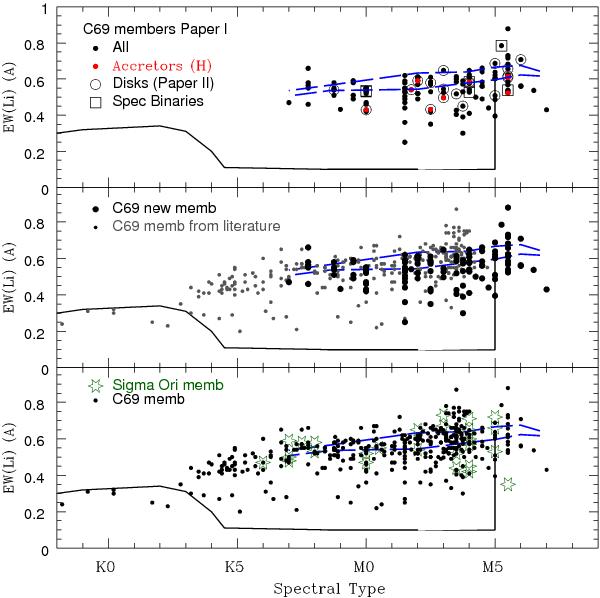Fig. 7

Lithium equivalent width (EW, in Å) versus the spectral type for different sets of spectroscopically confirmed members of Collinder 69. Top: new members reported in this work where accretors (based on the Hα emission, see Paper II for details) are highlighted in red, and class II sources (based on IRAC data, see Barrado y Navascués et al. 2007 and Paper II) and spectroscopic binaries (from Sacco et al. 2008 and Maxted et al. 2008) are surrounded by open circles and squares, respectively. Middle: new members are shown as filled black circles, while members from the literature (Dolan & Mathieu 1999, 2001; Barrado y Navascués et al. 2004b, 2007) are shown as smaller grey circles. Bottom: comparison of Collinder 69 members (joining the samples from the middle panel), displayed as filled black dots, with Sigma Orionis low mass stars from Zapatero Osorio et al. (2002), represented with star symbols. In all the panels, the solid line traces the upper envelope of the values measured in older clusters such as IC 2391, IC 2602, the Pleiades, and M 35; and the short-dashed blue lines corresponds to the cosmic abundances – A(Li) = 3.1 – from gravities of log g = 4.5 and 4.0, respectively (curves of growth from Zapatero Osorio et al. 2002).
Current usage metrics show cumulative count of Article Views (full-text article views including HTML views, PDF and ePub downloads, according to the available data) and Abstracts Views on Vision4Press platform.
Data correspond to usage on the plateform after 2015. The current usage metrics is available 48-96 hours after online publication and is updated daily on week days.
Initial download of the metrics may take a while.


